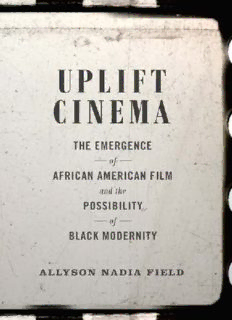
Uplift Cinema: The Emergence of African American Film and the Possibility of Black Modernity PDF
Preview Uplift Cinema: The Emergence of African American Film and the Possibility of Black Modernity
UPLIFT CINEMA U P L I F T C I N E M A The Emergence of African American Film and the Possibility of Black Modernity ALLYSON NADIA FIELD Duke University Press · Durham and London · 2015 © 2015 DUKE UNIVERSITY PRESS. All rights reserved. Printed in the United States of America on acid- free paper ♾ Typeset in Minion Pro by Tseng Information Systems, Inc. Interior design by Courtney Leigh Baker. Library of Congress Cataloging-in-Publication Data Field, Allyson Nadia, 1976– Uplift cinema : the emergence of African American film and the possibility of black modernity / Allyson Nadia Field. pages cm Includes bibliographical references and index. isbn 978-0-8223-5907-4 (hardcover : alk. paper) isbn 978-0-8223-5881-7 (pbk. : alk. paper) isbn 978-0-8223-7555-5 (e-book) 1. African Americans in the motion picture industry—History—20th century. 2. African Americans in motion pictures—History—20th century. I. Title. pn1995.9.n4f54 2015 791.43′652996073—dc23 2014046259 Cover art: Film still courtesy A/V Geeks. Duke University Press gratefully acknowledges Harvard Studies in Comparative Literature, which provided funds toward the publication of this book. for Werner CONTENTS Preface · ix Acknowledgments · xvii Introduction · 1 1 THE AESTHETICS OF UPLIFT The Hampton- Tuskegee Idea and the Possibility of Failure · 33 2 “TO SHOW THE INDUSTRIAL PROGRESS OF THE NEGRO ALONG INDUSTRIAL LINES” Uplift Cinema Entrepreneurs at Tuskegee Institute, 1909–1913 · 83 3 “PICTORIAL SERMONS” The Campaign Films of Hampton Institute, 1913–1915 · 121 4 “A VICIOUS AND HURTFUL PLAY” The Birth of a Nation and The New Era, 1915 · 151 5 TO “ENCOURAGE AND UPLIFT” Entrepreneurial Uplift Cinema · 185 Epilogue · 245 Notes · 259 Bibliography · 299 Index · 311 PREFACE A decade after Booker T. Washington’s death and the public outcry against D. W. Griffith’s Birth of a Nation, Oscar Micheaux released his thirteenth film, Body and Soul (1925). A major example of 1920s race film, Body and Soul be- came famous for the screen debut of Paul Robeson and infamous for the con- troversy over its representation of Black criminality. Typical for Micheaux’s work, the plot is far from straightforward, and its convoluted structure in- volves an array of figures that represent a range of character types—the full spectrum of Black humanity. Robeson plays twins who have opposite charac- teristics: a charlatan masquerading as a preacher named Reverend Jenkins and his brother Sylvester, an upstanding aspiring inventor. The film centers on the lives of Martha Jane (Mercedes Gilbert), a laundress, and her daughter Isabelle (Julia Theresa Russell). Isabelle is in love with Sylvester but Martha Jane pushes her toward Reverend Jenkins, not realizing that he is in fact a con man. Jenkins takes advantage of Martha Jane’s faith and assaults Isabelle. Because Martha Jane is blind to the truth of her “pastor,” he is able to extort her hard-e arned savings from her daughter. Knowing that her mother would never believe her word over that of Jenkins, Isabelle flees to Atlanta and dies of starvation, but not before Martha Jane has found her and learned the truth. No longer de- ceived by Jenkins, she confronts him in the middle of a Sunday sermon and turns his betrayed congregation against him. Escaping, Jenkins seeks forgive- ness from Martha Jane who relents, pardoning the con man. Showing no genu- ine remorse, he goes on to kill a young male parishioner in a gruesome attack in the middle of the woods. At this point, to add to the confusion, Martha Jane wakes up and reveals that it was all a nightmare. Having learned a lesson from the dream, however, she blesses the marriage of her daughter to Sylvester, the proper “uplift” man.
Description: